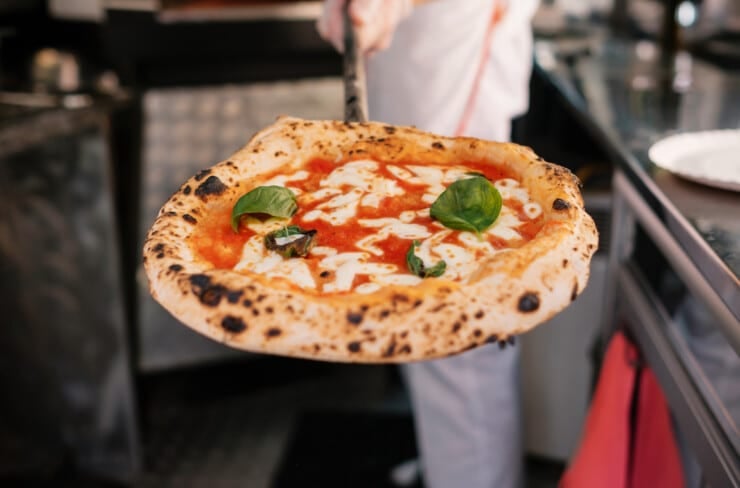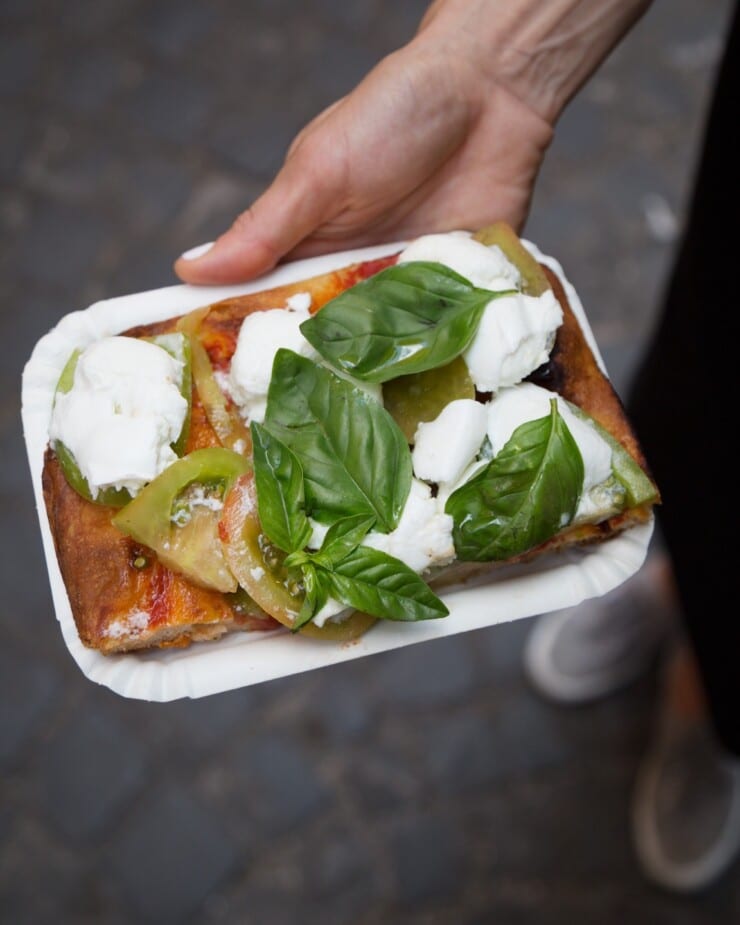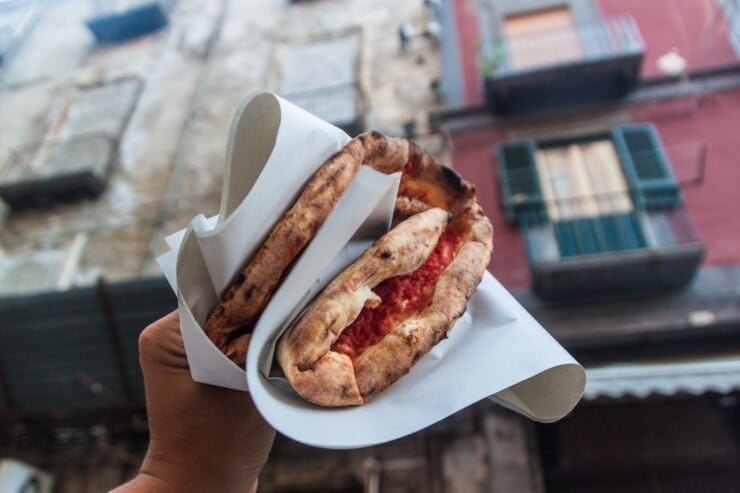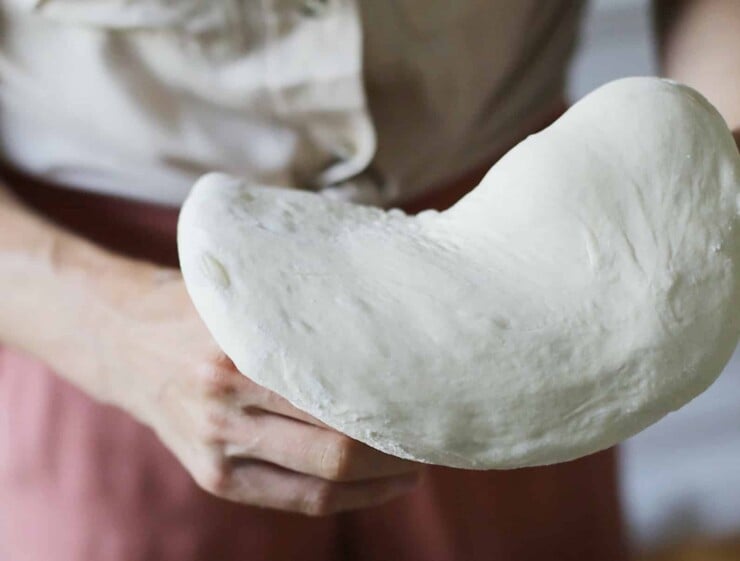Cheesy, gooey, golden, and crispy goodness: the most famous Italian dish is undoubtedly pizza. But, of course, pizza in Italy is never just pizza. Do you want a very thin crust or a thick, spongy crust? Is it cooked in a wood-fired oven or fried? Will you sit at a pizzeria or grab it as street food? Luckily, when it comes to pizza in Italy, you don’t have to choose.

10 Classic Types of Pizza In Italy to Try
If we’re being honest, the best pizza in the world is found in its birthplace, and, frankly, the bar is set for high quality. But the kind of pizza in Italy you find will differ from restaurant to restaurant, from pizzeria to pizzeria, and, often, region to region.
From Pizza Napoletana and Pizza Fritta to Pinsa and Pizza alla Pala, here are the ten types of pizzas to know about when traveling to Italy.
Pizza Napoletana (Naples)
The most classic pizza of all, Neapolitan-style pizza, is named after its birthplace: Naples. This style is the typical round pizza people often think of when Italian pizza comes to mind. This authentic Italian pizza has an ultra-thin crust that bakes in high-temperature wood-fired ovens for only 60 to 90 seconds, resulting in the trademark crust with a crispy exterior and a soft and chewy interior.
Unlike pizzas you might be used to in the United States, Neapolitan pizza won’t be served pre-cut. It requires a fork and knife because the thin crust doesn’t accommodate holding up a slice.
This dish is such a staple of pizza in Italy that in 2017, it was listed as a UNESCO Representative List of the Intangible Cultural Heritage of Humanity. By last count, there are over 800 pizzerias in Naples, and some of the most famous pizzerias for authentic Neapolitan pizza include Antica Pizzeria da Michele and Pizzeria La Notizia.

Pizza Fritta (Naples)
What could be even more mouthwatering than pizza? Pizza, but deep-fried. Traditionally, pizza fritta is made by taking fried pizza dough and stuffing it with salami, lard, smoked provola cheese, ricotta, and tomatoes. Pizza fritta emerged in Naples during World War II when quality ingredients were scarce, and the bombing had destroyed many ovens.
Deep-frying pizzas made for a tasty meal. Today, your pizza fritta will be made from excellent dough and toppings, and the cooking process makes it easy for street vendors to prepare a tasty snack, no oven needed. Try it in Naples at Antica Pizza Fritta da Zia Esterina Sorbillo dal 1935.
Pinsa (Rome)
You read that right: pinsa, not pizza. This Roman-style pizza has delicately hand-pressed dough that has just the right amount of crisp and a whole lot of soft texture on the inside.
The name pinsa comes from the Latin verb pinsere, meaning “to stretch” or “to spread,” it’s named such because the pizza maker spreads the dough by hand into an oval shape. The Pinsa dough’s higher water content means it can’t be tossed and shaped in the air, but hand-shaping creates a signature wavy texture.
Pizza alla Pala (Rome)
A high-hydration, long-rising dough helps to make this a favorite type of Roman pizza. Unlike a pizza Napoletana, this tasty pizza bakes in an electric oven. The result? A crispy flatbread with a fluffy interior and a unique, elongated shape that mirrors the pizza peel on which it’s typically served. The pizza gets its name from the pizza peel since it resembles a shovel, known as pala in the Italian language. Go to Casa Manco in the Testaccio market to taste this style.
Pizza Tonda Romana (AKA Scrocchiarella) (Rome)
Pizza Tonda Romana is a Roman pizza variety with a surprising crunch. This pizza dough has less water than Neapolitan pizza, which results in a thin, cracker-like crust when baked. A hallmark of this style is a slight char, a consequence of baking at higher temperatures.
This Roman round pizza boasts an ultra-thin, crisp crust that holds its shape when picked up. Attempting to fold a slice results in a characteristic crack, referred to as “scrocchiarella,” making this crunchiness a distinctive feature. A beloved spot for this in Rome is at Emma Pizzeria con Cucina.

Pizza al Taglio (Rome)
Among Italian Americans, this is probably the second most popular pizza in Italy after the Neapolitan style. When you order pizza al taglio, you get your pizza by the slice, meaning you specify just how much you want, and you pay by weight. Because of its easy on-the-go nature, pizza al taglio makes a perfect street food.
This particular pizza in Italy has a longer baking time in an electric oven — up to fifteen minutes — giving it a thick, golden crust that’s airy and oh-so-satisfying. To prevent overcooking or unnecessary cooking, some of these pizza accessories are applied mid-bake or after-bake. The most popular pizza in Italy of this style in ancient Rome is easily Bonci Pizzarium near Vatican City (there will be a line!) as it’s always among the rankings of best pizzerias. We also enjoy the thinner style found at Antico Forno Roscioli.
Pizza al Padellino (Turin)
Meaning “pizza in a little pan,” this variety hails from Torino in Northern Italy and dates back to the 1950s. Baked in a small, round pan results in an easy personal pizza. During the baking process, the dough rises considerably, which results in a soft, fluffy texture more akin to deep-dish pizza in the U.S. Oil placed in the pan fries the outside, though, adding a delightful bit of crispiness.

Pizza Siciliana (AKA Sfincione) (Sicily)
This Sicilian pizza is often called simply sfincione (pronounced “sfeen-cho-nay”), and it’s a spongy, oily (in a good way!) pizza. It originated in Bagheria and remains a popular Sicilian street food. Sfincione has a thick crust reminiscent of focaccia due to a longer rising time.
Traditionally, vendors sell them in rectangles — making pizza Siciliana a delicious on-the-go snack — traditionally topped with a mix of olive oil, onions, anchovies, caciocavallo cheese, breadcrumbs, and some herbs and vegetables.
It must be said that most Sicilians don’t consider this pizza since the crust is more akin to American-style deep dish pizza. However, it is considered part of the pizza family by most Italians these days. Try it for yourself at Panificio Pietro Bonaccorso in the Vucchiria market.
Pizza all’Andrea (AKA Sardenaira)
No cheese? No problem! Sardenaira keeps the toppings simple yet savory: salted anchovies, olives, garlic cloves, and capers. This dish was named after admiral Andrea Doria, who loved nothing more than a slice of bread with those few ingredients. Sardenaira technically predates pizza Napoletana, which most consider the actual grandfather of pizzas. Some might consider it more of a focaccia with toppings than a pizza, but we don’t discriminate.
Pizza Classica (AKA Pizza Tradizionale)
Pizza Classica is less of a specific style of pizza and more a catch-all term for a generic pizza. You won’t seek this type out, but as a traveler, some pizza tradizionale may be inevitable. Pizza Classica differs from the generic pizza you’ll find in America, usually because pizza Napoletana is the model. The result is a pizza with thinner crusts and smaller, round pies with the classic toppings — mozzarella, basil, or prosciutto, for instance.
Frequently Asked Questions
It's speculated that the word pizza came from the Greek word “pitta,” meaning “pie.”However, some historians believe the word came from the Lombardic word “bizzo,” which means “bite.” Latin texts from 977 Italy have been entered into a 1598 Italian-English dictionary as “a small wafer or cake.”
These are five classic pizza toppings you'll see in Italy:
- Margherita: Known as the queen of pizzas, it's a simple yet beloved choice with mozzarella (for dil atte or de bufala), tomato, oil, and basil.
- Marinara: A testament to simplicity, this pizza is made with tomato, garlic, oregano, oil, and sometimes basil.
- Prosciutto e Funghi: A ham and mushroom pizza that comes in two versions: with cooked ham or with cured ham added after cooking.
- Quattro Stagioni: Meaning "Four Seasons," this pizza has cooked ham, mushrooms, artichokes, and black olives, each placed in its quarter or section.
- Capricciosa: Similar to Quattro Stagioni but with ingredients mixed on a base of tomato sauce and mozzarella.
While pizza has technically been around for centuries, it gained popularity around the late 19th century and early 20th century when Italian immigrants first came to the United States. Pizza got an astronomical boost in popularity once Italian Immigrants settled in Northeast cities, and the food spread regionally after American soldiers stationed in Italy returned from WWII.

The History of Pizza In Italy
First, let’s dive into the history of pizza in Italy. Is pizza originally from Italy, you ask? Well, yes and no. Part of that has to do with how you define pizza. As we discussed when discussing the difference between focaccia and pizza, we consider pizza to be flatbread with a lot of toppings.
As long as a breadlike product has existed, people have added toppings to it to create a convenient and delicious food. Along those lines, pizza’s history has roots in ancient times when the Greeks, Egyptians, Armenians, Israelis, and Babylonians would cook flatbreads in clay ovens. Some topped the bread with oil and spices, resulting in something similar to focaccia.
But a key ingredient was missing to turn these flatbreads into traditional Italian pizza: tomatoes. Spanish conquistadors brought tomatoes from Mexico to Europe in the 1500s, but they believed the fruit was poisonous, so it was used purely for aesthetics. Fortunately, people eventually discovered that tomatoes were not only edible but delicious.
The tomato furthered the evolution of pizza as it topped flatbreads in Naples, Italy. The bustling waterfront city was founded as a Greek settlement around 600 B.C. and had a large population of working poor who needed something inexpensive to eat. Thus, pizza as we know it today was born. However, pizza remained a Neapolitan food for quite some time as it wasn’t well known in the rest of Italy until the 1940s (by then, pizza had already been in the US for decades)!

The Queen of Pizza
If you had to identify the most classic Italian pizza, many would point to the Margherita pizza. True to the Naples-style pizza, it has few ingredients, but they’re all high-quality: namely, pomodori (fresh tomatoes), fresh mozzarella cheese (often fior di latte), and basilico (fresh basil).
Legend has it that in 1889, pizzaiolo Raffaele Esposito was tasked with making a pizza for Queen Margherita of Savoy, the first Queen of Italy, to celebrate the recent Italian unification. He named the pizza after her and chose different toppings that reflected the colors of the Italian flag. This pizza in Italy has persevered as a classic combo of toppings for pizza and has cemented the Margherita as the queen of pizzas.
Popular Pizza Toppings
Speaking of pizza toppings, the most popular pizza toppings include high-quality ingredients like tomato sauce, prosciutto (dried ham), funghi (mushrooms), olive (olives), anchovies, artichokes, mushrooms, and cheeses like burrata, buffalo mozzarella, or Parmigiano-Reggiano (parmesan).
Typically, less is more when it comes to pizza toppings in Italy because, as you’ll see in our list, most crusts aren’t built to hold heaps of ingredients. But even then, there’s a difference among parts of Italy. For example, Neapolitan pizza has a soft, tender crust with a few high-quality toppings, while Roman pizza showcases a crisper crust with a more extensive array of toppings.

How To Identify A Good Pizza In Italy
Identifying a high-quality pizza goes beyond its primary composition of dough, sauce, and toppings. Italian pizza makers, or pizzaioli, uphold stringent standards for every element, from the dough’s hydration and fermentation duration to the provenance and freshness of the ingredients. They prefer regional ingredients renowned for their quality and freshness.
When discerning the quality of an Italian pizza, consider the crust, ingredients, and baking technique. A premium crust on a Neapolitan pizza (the most classic pizza) is characterized by a thin middle and a puffy, charred perimeter known as the cornicione. Top-notch ingredients are essential, with a preference for fresh, local produce like San Marzano tomatoes, buffalo mozzarella, and basil. Ultimately, a high-quality Italian pizza is distinguished by a harmonious flavor profile and a thoughtful combination of toppings.
Get A Personalized Travel Itinerary

Pizza Recipes to Make at Home
If you’d like to bring a taste of Italy into your kitchen, we’ve got you covered:
Basic Pizza Dough
Start with a reliable basic dough recipe. Beginner-friendly, this dough has the versatility to make pizza, calzones, or even go on the grill.
Truffled Mushroom Pizza
This truffled mushroom prosciutto recipe packs a serious punch. It has plenty of rich, earthy flavors with only three main toppings combined sublimely.
White Pizza
If you’d like to try a white pizza (which has no sauce), we recommend this honey balsamic fig and prosciutto pizza recipe. With plenty of sweetness and just the right amount of tart, the lack of sauce makes it feel lighter and perfect for an appetizer.
Have Us Plan Your Trip to Italy
What pizza from Italy are you most excited to try next? Comment below and let us know! Or, if you’d instead try the real thing on your next adventure, contact us about planning a trip to Italy.
Photo Credits: Opening photo by gwozdeff ; Margherita pizza by Louis Hansel on Unsplash; pizza fritta by jubrano; sfincione by claudio rampinini